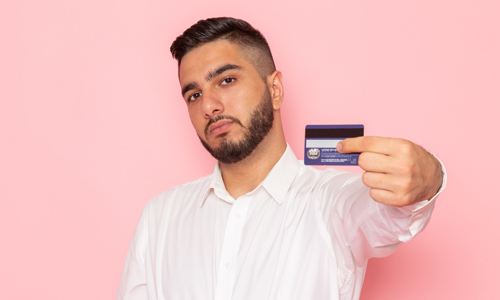How to Spot a Fake Credit Card

The progress of technology has simplified banking products and services to a great extent. With the advancement of facilities, banks and financial institutions now provide multi-layer protection against fraud and counterfeiting. However, offenders still find multiple ways of duplicating products like debit and credit cards, which can cause significant losses, especially to the merchants. If you own a business or work at a mall or a shop, you should be able to identify a fake credit card. This simple skill can save you a lot of money and time.
Fake credit cards have minute variations in features compared to genuine cards. A closer look at the unique markers on the credit card can help you spot a counterfeit credit card. The chip and pin security has considerably reduced counterfeiting. At the same time, you need to be aware while performing transactions through credit cards. So if you want to know some methods to spot a fake credit card and avoid being scammed, read more below.
Signs of a Fake Credit Card
Credit cards have numerous details including payment channel logos like Mastercard, Visa or American Express, holograms, metallic chips, and so on. Unlike a genuine credit card, fake credit cards don’t have well-crafted precise details. To spot a fake credit card, you can review the following signs and details.
- Numbers on the Credit Card
- Card Number Not Matching with The Issuer’s Number
- The Holograms On the Credit Card
- Signature Panels On the Credit Card
- Missing CVV Code
- Damaged Magnetic Strips in The Credit Card
- Missing or Unreadable Chip On the Credit Card
- Variation in The Last Four Digits of the Card
- Micro Prints On the Credit Cards
- UV Logos
Numbers on the Credit Card
Every cardholder is issued a unique number that is embossed on the plastic or metallic card, or simply printed on the credit card. A genuine card has evenly spaced numbers that are lined up precisely. On the other hand, a fake card tends to carry uneven numbers with varying spaces. The reason for this lies in the fact that the aftermarket embossing machines print the numbers separately, ultimately creating incoherent combinations. You may also find a few fake credit cards numbers of different sizes thicknesses. While performing transactions, you should look at the appearance of the embossed numbers to verify a genuine credit card.
Card Number Not Matching with The Issuer’s Number
All major credit card issuers have a unique number series. Your credit card may have between 13 to 19 digits, depending on the issuer. If you are aware of the starting digits of different prominent credit cards issuers, you can easily identify a fake credit card. Following are the initial digits of major issuers in the UAE.
|
Credit Card Issuer |
Beginning Digit On The Credit Card |
|---|---|
|
American Express |
34 or 37 |
|
Mastercard |
5 |
|
Visa |
4 |
|
Discover |
6 |
While noticing the numbers on the credit card, you can easily conclude if the card is fake or not, based on the starting series of a specific issuer’s credit card. For instance, a Visa credit card starts with the digit ‘4’. So if you detect a Visa card beginning with another number, say 9, you can easily know it to be counterfeit.
The Holograms On the Credit Card
Holograms are 3D patterns that show different images and marks when viewed at different angles. As it is multi-layered imagery, holograms are difficult to copy, reducing the chance of counterfeiting. All major payment channels use holograms to enhance their card security. While Mastercard and Visa have holograms either on the front or the back of the card, an American Express credit card has holograms on the magnetic strips.
If you notice a hologram that is dull, damaged or appears two-dimensional, chances are that you have encountered a fake credit card. For enhancing your awareness, you can study the images and patterns printed on several genuine credit cards to easily compare them with the ones you are dealing with.
Signature Panels On the Credit Card
Ever noticed the signature panel of a credit card? It is sufficient to help you find out if a credit card is fake or not. If the panel appears damaged, scratched, or of colours other than white, you might be dealing with a fake credit card. All major credit card issuers place their signature panel at the bottom of the magnetic strip in white colour. In fact, an unsigned credit card is probably a fake credit card, although you need to check various other factors before coming to conclusion.
Missing CVV Code
Every credit card includes a CVV (Card Verification Value) to increase security and reduce fraudulent digital transactions. While Mastercard, Visa, and Discover cards have a three-digit CVV number either on the back or beside the signature panel, American Express credit cards have a CVV number on the front that is directly above the brand logo. However, if you find a credit card without a CVV, the credit card is most probably counterfeit. Thus, it is vital to ensure that a credit card has a valid CVV before performing transactions.
Damaged Magnetic Strips in The Credit Card
Magnetic strips, which store data related to your credit card, are registered with the bank and payment channels. The fraudsters and offenders damage, alter or remove the credit card strips to prevent their use at the POS and swipe machines. Due to damage, the seller or the cashier needs to enter the card details manually, resulting in a fraudulent transaction.
Missing or Unreadable Chip On the Credit Card
Similar to the damaged magnetic strips, a missing chip on a credit card also prevents its registration at a POS and swipe machines. This too leads to eventual loss for the merchant.
Variation in The Last Four Digits of the Card
A great way to spot a counterfeit credit card is to verify the number on the credit card and the last four digits of the card mentioned on the bill or the sales receipt. If both the numbers don’t match, you are dealing with a fake credit card.
Micro Prints On the Credit Cards
Most credit card issuers have micro print verification numbers printed under the brand logo or the account numbers. These numbers can be seen through a magnifying glass, with the credit card being fake if the numbers are missing. As more than 80% of fake credit cards have micro-print numbers missing this is one of the most precise methods to verify genuineness.
UV Logos
If you have access to UV or black light check, you can verify the UV logos printed on the credit card. All the major credit card issuers use UV logos to prevent counterfeiting. For American Express credit cards, you can find ‘AM EX’ in the front of the credit card. In the case of Mastercard, you can verify an ‘MC’ sign in the front. You can seek for flying V sign with a dove logo on the lower-left corner of the credit card. Finally, for Discovered credit cards, you can find Discover printed across the card.
How to Handle a Credit Card Fraud?
If you encounter a fake credit card or have been a victim of credit card fraud, you need to take the following steps without any delays to reduce your losses.
- Notify your Bank and Credit Bureau - Credit card fraud can often go unchecked if you delay the reporting. Consequently, it is recommended to report to your bank and the credit card bureau immediately after finding that you have been cheated. You would be needed to fill out a claim form as per the issuer’s procedure and submit relevant documents.
- Add a Fraud Alert to Your Credit Report - If you activate the fraud alert service in your credit card account, your issuer implements an additional step to confirm identity before processing a transaction. This is an excellent prevention against the offenders opening a credit account using your details.
- File a complaint with Local Law Enforcement Authorities - As additional security, you can also file a report with the local law enforcement authorities stating the fraudulent activity. While doing so, you will need to carry your identity and address proof, and other relevant information.
- Use Security Freeze Facility in Your Credit Card - You can always freeze your credit card in the case of fraud by logging into your credit account. The issuer blocks your card details for future transactions.
How Offenders Use Fake Credit Card Generators for Frauds?
Offenders may use a fake credit card generator to prepare a counterfeit credit card and use a fake address generator to buy the credit card at a valid address. Using a randomly generated address, they ensure that the fake transaction remains free of tracing. However, they do not validate the numbers immediately. Instead, they try shopping frequently number by number until one card passes through. These kinds of offenders use small and frequent transactions to experiment with a number of fake credit card generators.
If you want to stay free of concerns amidst the prevalence of such offenders as a cardholder, you should keep a frequent eye on your credit report. You can also check your credit card declaration to protect yourself from credit card generator fraud.
Conclusion
Both credit card owners and merchants can be victims of credit card fraud. However, on average, shop owners and merchants are at greater risk from fake credit cards. As approving payment from fake cards can cost them huge penalties, the sellers require greater attention against fake credit cards.
While all this may appear intimidating, the important aspect here is that by being vigilant and aware of the basic signs of a fake credit card, you can easily save your money and time by preventing such fraud instances.
Related Links-
How to Protect Yourself from Credit Card Fraud
More From Credit Cards
- Recent Articles
- Popular Articles




















